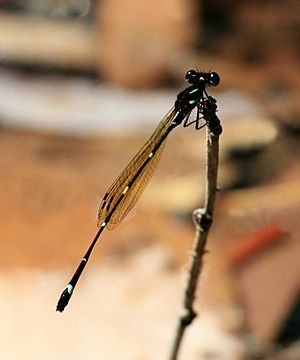Nososticta facts for kids
Quick facts for kids Nososticta |
|
|---|---|
 |
|
| Nososticta solitaria, Cairns | |
| Scientific classification |
|
| Kingdom: | Animalia |
| Phylum: | Arthropoda |
| Class: | Insecta |
| Order: | Odonata |
| Suborder: | Zygoptera |
| Family: | Platycnemididae |
| Genus: | Nososticta Hagen, 1860 |
Nososticta is a group of beautiful insects called damselflies. They are often known as Threadtails because of their very thin bodies. These amazing creatures can be found in many parts of the world, from Africa all the way to Indonesia and Australia.
Contents
What are Damselflies?
Damselflies are a type of insect that looks a lot like dragonflies. Both are part of a group called Odonata. Damselflies are usually smaller and more delicate than dragonflies. When they rest, most damselflies hold their wings together over their back. Dragonflies, on the other hand, usually hold their wings out flat.
All About Threadtails
The Nososticta damselflies, or Threadtails, get their common name from their long, slender bodies. They are often brightly colored, with shades of blue, green, red, or yellow. These colors help them blend in with their surroundings or attract mates.
Where Do Threadtails Live?
Threadtails live in many different places around the world. You can find them in parts of Africa, across the islands of Indonesia, and throughout Australia. They usually live near water, like rivers, streams, and ponds. This is because damselflies need water for their young to grow.
Life Cycle of a Damselfly
Like many insects, damselflies go through several stages in their life. It's called an incomplete metamorphosis.
- Eggs: Female damselflies lay their eggs in or near water. They often place them on underwater plants.
- Nymphs: When the eggs hatch, tiny creatures called nymphs (or larvae) come out. These nymphs live underwater. They breathe using gills, which are like tiny feathery structures. Nymphs are predators; they hunt and eat other small water creatures. They grow by shedding their skin many times.
- Adults: After growing enough, the nymph crawls out of the water, often onto a plant stem. Its skin splits open, and the adult damselfly emerges. The adult damselfly has wings and can fly. Its main job is to find a mate and lay eggs, starting the cycle all over again. Adult damselflies also eat smaller insects, catching them in the air.
Many Kinds of Threadtails
The genus Nososticta includes many different species, each with its own unique look and habitat. Scientists have identified many types of Threadtails, showing how diverse these damselflies are. Some examples of the species include:
- Nososticta africana
- Nososticta astrolabica
- Nososticta atrocyana
- Nososticta aurantiaca
- Nososticta baroalba
- Nososticta beatrix
- Nososticta callisphaena
- Nososticta chalybeostoma
- Nososticta circumscripta
- Nososticta coelestina
- Nososticta commutata
- Nososticta cyanura
- Nososticta diadesma
- Nososticta dorsonigra
- Nososticta eburnea
- Nososticta egregia
- Nososticta emphyla
- Nososticta erythroprocta
- Nososticta erythrura
- Nososticta evelynae
- Nososticta exul
- Nososticta flavipennis
- Nososticta fonticola
- Nososticta fraterna
- Nososticta insignis
- Nososticta irene
- Nososticta kalumburu
- Nososticta koolpinyah
- Nososticta koongarra
- Nososticta liveringa
- Nososticta lorentzi
- Nososticta marina
- Nososticta melanoxantha
- Nososticta moluccensis
- Nososticta mouldsi
- Nososticta nigrifrons
- Nososticta nigrofasciata
- Nososticta phoenissa
- Nososticta pilbara
- Nososticta plagiata
- Nososticta plagioxantha
- Nososticta pseudexul
- Nososticta pyroprocta
- Nososticta rangifera
- Nososticta rosea
- Nososticta salomonis
- Nososticta selysi
- Nososticta silvicola
- Nososticta solida
- Nososticta solitaria
- Nososticta tarcumbi
- Nososticta thalassina
- Nososticta wallacii
- Nososticta xanthe

